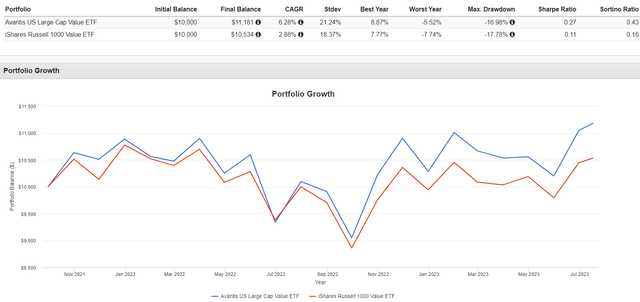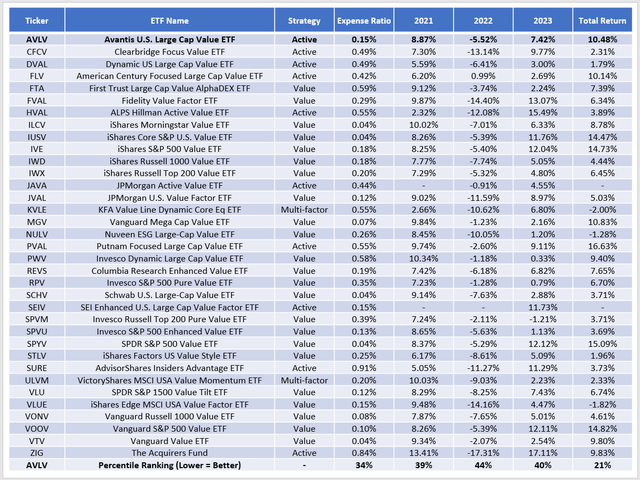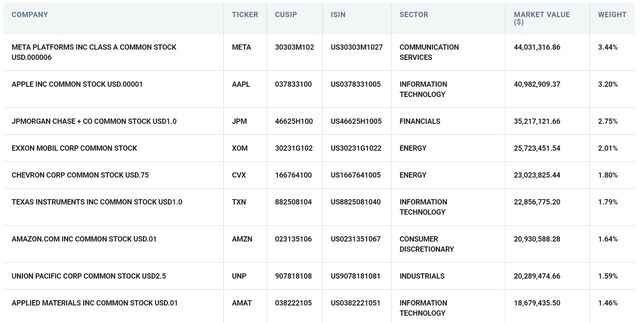Investment Thesis
Today, I am initiating coverage on the Avantis U.S. Large Cap Value ETF (NYSEARCA:AVLV), an actively-managed fund with a low 0.15% expense ratio and $1.27 billion in assets under management. As you’re well aware, large-cap value ETFs have substantially underperformed large-cap growth ETFs in 2023 by 20-25%, and while AVLV has also struggled, it’s a solid fund with an above-average, albeit limited, track record. In this article, I will compare AVLV’s historical performance against dozens of peers and evaluate the ETF fundamentally against popular alternatives like SPYV and VTV. While I don’t think AVLV stands out in this crowded category, I ask readers to put it on their watchlist to diversify their value portfolio by style in a cost-effective way. I hope you enjoy the analysis.
AVLV Overview
Strategy Discussion
According to AVLV’s fact sheet, the primary objective is long-term capital appreciation, not income. AVLV offers many of the same benefits associated with indexing (diversification, low turnover, transparency) but is actively managed, allowing its fund managers to take advantage of current opportunities without waiting for a scheduled rebalancing. For a 0.15% expense ratio, that’s a good deal, assuming managers are skilled.
The results so far indicate they are. Using the iShares Russell 1000 Value ETF (IWD) to reflect the performance of its stated benchmark, AVLV delivered an annualized 6.28% gain since its September 2021 launch, compared to 2.88% for IWD. Volatility was higher, but not in a bad way. AVLV’s Sortino, which measures downside risk-adjusted returns, was substantially better at 0.43 vs. 0.16 for IWD. Furthermore, its maximum 16.96% drawdown between April and September 2022 was about 1% less.
Portfolio Visualizer
These results form the foundation for a buy recommendation. However, IWD is just one large-cap value ETF on the market. I identified 33 others in my ETF database, and since it’s not prudent to own them all, let’s look closer at how AVLV performed against those next.
Performance Analysis
The following table highlights annual returns for AVLV, IWD, and 33 other large-cap value ETFs. Please note that performance was limited to the last three months of 2021, while 2023’s returns are YTD through June.
The Sunday Investor
This table reveals how AVLV’s 8.87%, -5.52%, and 7.42% returns between 2021-2023 were in the second quartile, which led to a 10.48% total return that beat out nearly 80% of large-cap value peers. I like consistent performers, as it indicates managers didn’t just get lucky one year, which could skew the results. However, this table also reveals the competition. On total returns, the following nine ETFs produced a similar or better result:
- American Century Focused Large Cap Value ETF (FLV)
- iShares Core S&P U.S. Value ETF (IUSV)
- iShares S&P 500 Value ETF (IVE)
- Vanguard Mega Cap Value ETF (MGV)
- Putnam Focused Large Cap Value ETF (PVAL)
- SPDR S&P 500 Value ETF (SPYV)
- Vanguard S&P 500 Value ETF (VOOV)
- Vanguard Value ETF (VTV)
- ETF Series Solutions – The Acquirers Fund (ZIG)
Furthermore, PVAL and SPYV are two other ETFs that never ranked in the third or fourth quartiles. PVAL is another actively-managed fund, but it’s only a semi-transparent fund with 48% portfolio turnover last year, so it’s a more challenging fund to analyze. Still, we have a group of nine ETFs that might be considered suitable alternatives to AVLV, so let’s look at how AVLV compares to a few of them in more detail next.
AVLV Analysis
Sector Exposures and Top Ten Holdings
Sector exposures for SPYV, VTV, PVAL, and AVLV are below. Please note that PVAL’s figures are only approximate due to its structure. The current tracking basket has a 77.49% overlap with the actual portfolio.
Morningstar
In many ways, the four ETFs have similar exposure areas. However, AVLV overweights Consumer Discretionary (14.00%) and Communication Services (10.40%) and is noticeably light on Consumer Staples (4.02%) and Health Care (6.93%). These differences likely lead to a more volatile portfolio.
AVLV’s top ten holdings are listed below, totaling 22% of the fund. Meta Platforms (META) is the top holding, as the company has recently changed focus in favor of operational efficiency rather than growth. Apple (AAPL) is an unusual choice; it trades at 32.51x forward earnings and yields just 0.49%. Finally, JPMorgan Chase (JPM) aligns more with what value investors expect. The bank trades at 9.60x forward earnings and has a decent 2.61% yield.
Avantis Investors
AVLV Fundamentals
The following table highlights selected fundamental metrics for AVLV’s top 25 holdings. In the final row, I’ve also included summary metrics for SPYV, VTV, and PVAL. As a reminder, PVAL’s metrics are based on the current tracking basket and are only partially accurate.
The Sunday Investor
The first standout metric is AVLV’s 1.22 five-year beta, substantially higher than the other three ETFs. Only three others in the 35 ETF sample from earlier (SURE, ZIG, RPV) have higher betas, so AVLV is undoubtedly different than what you’re likely used to. Regarding overlap, AVLV has only 37%, 33%, and 15% with SPYV, VTV, and PVAL, so it could complement passive ETFs well.
The second metric I want to highlight is how AVLV’s current holdings had a 104.69% total return over the last three years, substantially more than its peers. In this sense, it’s not a typical value fund. I already mentioned how Apple was an odd selection, but AVLV has 6.80% and 4.49% exposure to the Oil & Gas E&P and Integrated Oil & Gas industries. Constituents in these industries are up 265.08% and 158.68% in the last three years, but Energy is a key overweight area for AVLV that has stunted returns so far in 2023. Exxon Mobil (XOM), Chevron (CVX), and ConocoPhillips (COP) are all down YTD.
AVLV offers 6.30% estimated earnings growth and trades at 16.99x forward earnings, which is better than SPYV and VTV, but worse than PVAL’s 9.30% and 17.03x figures. However, the downside is weak earnings momentum driven by AVLV’s high allocation to Energy stocks. AVLV’s constituents had an impressive Q1 2023 earnings season, delivering a weighted average 10.01% earnings surprise. However, Wall Street isn’t as bullish this quarter, especially after Exxon Mobil forecasted “sharply lower” Q2 earnings from lower natural gas prices and tighter oil margins. It remains to be seen how much is baked into share prices, but we won’t have to wait too long to find out. Both Exxon Mobil and Chevron are scheduled to release earnings on July 28.
Investment Recommendation
AVLV is a solid large-cap value ETF that offers the benefits of active management at a low cost. However, it operates in a crowded category, and nine other ETFs have outperformed AVLV since its September 2021 launch. While AVLV’s fundamentals look strong, particularly its combination of growth and valuation, I’m concerned with its 14.5% exposure to the Energy sector and relatively weak earnings momentum compared to passive alternatives like SPYV and VTV. Therefore, I’ve set my rating to a “hold”, but I look forward to discussing AVLV and other large-cap value ETFs in the comments section below. Thank you for reading.
Read the full article here












